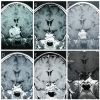Characteristic of Tumor Regrowth After Gamma Knife Radiosurgery and Outcomes of Repeat Gamma Knife Radiosurgery in Nonfunctioning Pituitary Adenomas
- PMID: 33763363
- PMCID: PMC7982800
- DOI: 10.3389/fonc.2021.627428
Characteristic of Tumor Regrowth After Gamma Knife Radiosurgery and Outcomes of Repeat Gamma Knife Radiosurgery in Nonfunctioning Pituitary Adenomas
Abstract
Objective: This study aimed to report the characteristic of tumor regrowth after gamma knife radiosurgery (GKRS) and outcomes of repeat GKRS in nonfunctioning pituitary adenomas (NFPAs).
Design and methods: This retrospective study consisted of 369 NFPA patients treated with GKRS. The median age was 45.2 (range, 7.2-84.0) years. The median tumor volume was 3.5 (range, 0.1-44.3) cm3.
Results: Twenty-four patients (6.5%) were confirmed as regrowth after GKRS. The regrowth-free survivals were 100%, 98%, 97%, 86% and 77% at 1, 3, 5, 10 and 15 year, respectively. In multivariate analysis, parasellar invasion and margin dose (<12 Gy) were associated with tumor regrowth (hazard ratio [HR] = 3.125, 95% confidence interval [CI] = 1.318-7.410, p = 0.010 and HR = 3.359, 95% CI = 1.347-8.379, p = 0.009, respectively). The median time of regrowth was 86.1 (range, 23.2-236.0) months. Previous surgery was associated with tumor regrowth out of field (p = 0.033). Twelve patients underwent repeat GKRS, including regrowth in (n = 8) and out of field (n = 4). Tumor shrunk in seven patients (58.3%), remained stable in one (8.3%) and regrowth in four (33.3%) with a median repeat GKRS margin dose of 12 (range, 10.0-14.0) Gy. The actuarial tumor control rates were 100%, 90%, 90%, 68%, and 68% at 1, 3, 5, 10, and 15 years after repeat GKRS, respectively.
Conclusions: Parasellar invasion and tumor margin dose (<12 Gy) were independent risk factors for tumor regrowth after GKRS. Repeat GKRS might be effective on tumor control for selected patients. For regrowth in field due to relatively insufficient radiation dose, repeat GKRS might offer satisfactory tumor control. For regrowth out of field, preventing regrowth out of field was the key management. Sufficient target coverage and close follow-up might be helpful.
Keywords: aggressive; gamma knife; nonfunctioning; pituitary adenoma; radiosurgery; regrowth.
Copyright © 2021 Li, Wu, Quan, Fu, Cao, Li, Liang, Huang, Deng and Yu.
Conflict of interest statement
The authors declare that the research was conducted in the absence of any commercial or financial relationships that could be construed as a potential conflict of interest.
Figures






Similar articles
-
Initial Gamma Knife radiosurgery for nonfunctioning pituitary adenomas: results from a 26-year experience.Endocrine. 2020 May;68(2):399-410. doi: 10.1007/s12020-020-02260-1. Epub 2020 Mar 11. Endocrine. 2020. PMID: 32162186
-
Long-term results of Gamma Knife Radiosurgery for Postsurgical residual or recurrent nonfunctioning Pituitary Adenomas.Int J Med Sci. 2020 Jun 18;17(11):1532-1540. doi: 10.7150/ijms.47168. eCollection 2020. Int J Med Sci. 2020. PMID: 32669956 Free PMC article.
-
Gamma Knife radiosurgery as the initial treatment for elderly patients with nonfunctioning pituitary adenomas.J Neurooncol. 2021 Apr;152(2):257-264. doi: 10.1007/s11060-021-03724-8. Epub 2021 Feb 27. J Neurooncol. 2021. PMID: 33638114
-
Retreatment of vestibular schwannoma with Gamma Knife radiosurgery: clinical outcome, tumor control, and review of literature.J Neurosurg. 2018 Jul;129(1):137-145. doi: 10.3171/2017.3.JNS162033. Epub 2017 Oct 6. J Neurosurg. 2018. PMID: 28984523 Review.
-
Radiosurgery and fractionated radiotherapy for cavernous sinus meningioma: a systematic review and meta-analysis.Acta Neurochir (Wien). 2018 Dec;160(12):2367-2378. doi: 10.1007/s00701-018-3711-9. Epub 2018 Nov 5. Acta Neurochir (Wien). 2018. PMID: 30393820
Cited by
-
Repeat gamma knife radiosurgery for recurrent pituitary adenomas.J Endocrinol Invest. 2025 Jul;48(7):1589-1595. doi: 10.1007/s40618-025-02564-x. Epub 2025 Mar 20. J Endocrinol Invest. 2025. PMID: 40111591
-
Stereotactic radiosurgery for recurrent/residual nonfunctioning pituitary adenoma: a single-arm systematic review and meta-analysis.Acta Neurochir (Wien). 2024 Oct 2;166(1):392. doi: 10.1007/s00701-024-06296-4. Acta Neurochir (Wien). 2024. PMID: 39356336
-
Long-term tumor control following repeat gamma-knife radiosurgery of growing pituitary adenomas: a population-based cohort study.Acta Neurochir (Wien). 2024 Dec 6;166(1):494. doi: 10.1007/s00701-024-06341-2. Acta Neurochir (Wien). 2024. PMID: 39641851 Free PMC article.
-
Gamma knife radiosurgery for orbital cavernous hemangioma: a systematic review and single-arm meta-analysis.J Neurooncol. 2024 Sep;169(2):221-231. doi: 10.1007/s11060-024-04723-1. Epub 2024 Jul 29. J Neurooncol. 2024. PMID: 39075327
-
Clinical outcomes of benign brain tumors treated with single fraction LINAC-based stereotactic radiosurgery: Experience of a single institute.Tzu Chi Med J. 2022 Jun 27;34(4):462-472. doi: 10.4103/tcmj.tcmj_260_21. eCollection 2022 Oct-Dec. Tzu Chi Med J. 2022. PMID: 36578643 Free PMC article.
References
-
- Lucas JW, Bodach ME, Tumialan LM, Oyesiku NM, Patil CG, Litvack Z, et al. . Congress of Neurological Surgeons Systematic Review and Evidence-Based Guideline on Primary Management of Patients With Nonfunctioning Pituitary Adenomas. Neurosurgery (2016) 79(4):E533–5. 10.1227/neu.0000000000001389 - DOI - PubMed
-
- Sheehan J, Lee CC, Bodach ME, Tumialan LM, Oyesiku NM, Patil CG, et al. . Congress of Neurological Surgeons Systematic Review and Evidence-Based Guideline for the Management of Patients With Residual or Recurrent Nonfunctioning Pituitary Adenomas. Neurosurgery (2016) 79(4):E539–40. 10.1227/neu.0000000000001385 - DOI - PubMed
LinkOut - more resources
Full Text Sources
Other Literature Sources

